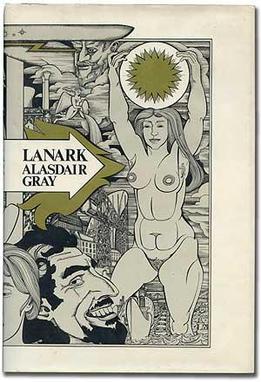Alasdair Gray’s Novel, “Lanark”
Not what I expected.
The Scots author-artist-alcoholic Alasdair Gray wrote his first novel Lanark (1981), subtitled “A Life in 4 Books,” over a period of thirty years, states its Wikipedia page. The book is also described here as a “cult classic.” Those words are hyperlinked to the eponymous Wiki page where, interestingly, novels are not mentioned as one of the categories of cult works of art. So what exactly is a cult classic novel?
Even at its daunting length of 573 pages, Lanark is a compelling read – although I find myself at a loss as to why I say so. It is, as others have commented, a bildungsroman, and unconventional in many respects, even as it lards itself with conventional lives of people (marriage, birth, divorce), barely preternatural aspects of the world (greed, poverty, politics) and common, everyday events (war, unrest, power). Gray has woven a fabric of whole cloth, to be sure, but its weave is far from uniform in color, texture, or perception. If there is meaning to be found, for this reader it was only in my own mind; I didn’t read anything worthy of my highlighter’s attention until page 410. On occasion, the author takes a turn into what may have defined in the early- to mid-20th century as surrealism, but it’s as if one were watching a movie on a broadcast television channel and, for some reason, decided to change the channel for a few moments or minutes but then flicked back to the movie. It doesn’t seem particularly important that some of Lanark’s movie has been excised. There are no new insights or revelations or deeper meaning to the “surrealistic” events. They’re just there, as-is, for better or worse, left to the reader’s own mental mindset to interpret.

This aberrance begins with the first pages of Lanark and persists throughout. Gray has decided, for some reason unclear to me, to begin with “Book Three,” then proceeds to revert back to “Book One,” skipping from Book Two over Three and then kind-of concluding with Book Four in which the narrator reveals himself and his writing process. Each book, which the author has dubbed a “canon,” is intersected with a short en·tr’acte. All in all, very pretentious for a tale of such little magnitude.
The central character, who has various names—Thaw, Lanark—is at root a very dull man, one who lives care-lessly, who achieves nothing and knows he doesn’t matter much to anyone. This reader, interested in what might happen, continues reading this very lengthy tome waiting for something to happen, but nothing does.
Perhaps Lanark is like the song by the Fugs, “Nothing.” If that was the author’s intent, he succeeded magnificently. In the fourth book he deconstructs the narrative, and himself, by creating a detailed list of reveals which he names “Index of Plagiarisms” that goes on for some 15 pages. He concludes with an onanistic Epilogue Q&A with himself, further explaining the explanations for writing the book.
Perhaps the theme or point to this novel can be summarized in the author’s own words: “The Thaw narrative shows a man dying because he is bad at loving. It is enclosed by your narrative which shows civilization collapsing for the same reason.” (p.484). This message arrives late to the party, and it’s a tell, not a show. Camus did much more with brevity and elan in The Stranger. Ditto for the author’s crude, lascivious pen-and-ink illustrations in the story’s otherwise complete absence of sensuality, sexuality, or . . . emotion at all.
If there had been even a little agenbite of inwit in the storytelling, we might have seen this truth but it doesn’t hold water in a single descriptive sentence. It’s so blatant as to suggest mendacity, and it’s not the only example of the author tossing topics erratically into the narrative instead of weaving and blending them into the aforementioned fabric. Is Alastair Gray the best author Scotland has to offer? I think not. I’d favor a novel by Ian Rankin any day.





